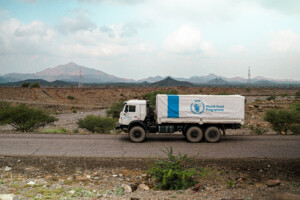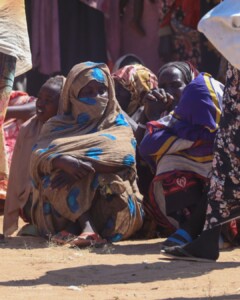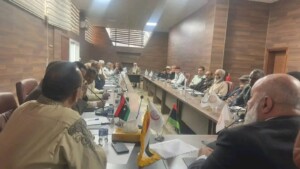Sudan OCHA bulletin 2: UNHAS to resume regular flights to South Kordofan and Blue Nile states
The UN Office for the Coordination of Humanitarian Affairs (OCHA) repors in its second biweekly bulletin of this year that The UN Humanitarian Air Service (UNHAS) is scheduled to resume early next month flights to South Kordofan and Blue Nile states. Pending approval from the Sudanese Civil Aviation Authority (SCAA) for an aircraft selected by UNHAS, flights are scheduled to start on 4 February to both Kadugli and Ed Damazine.

The UN Office for the Coordination of Humanitarian Affairs (OCHA) repors in its second biweekly bulletin of this year that The UN Humanitarian Air Service (UNHAS) is scheduled to resume early next month flights to South Kordofan and Blue Nile states. Pending approval from the Sudanese Civil Aviation Authority (SCAA) for an aircraft selected by UNHAS, flights are scheduled to start on 4 February to both Kadugli and Ed Damazine.
The UN Humanitarian Air Service (UNHAS) is scheduled to resume early next month flights to South Kordofan and Blue Nile states. Pending approval from the Sudanese Civil Aviation Authority (SCAA) for an aircraft selected by UNHAS, flights are scheduled to start on 4 February to both Kadugli and Ed Damazine.

UNHAS filght (WFP)
In January, SCAA announced any aircraft older than 20 years would no longer be allowed to operate within the country. Both UNHAS and the United Nations Interim Security Force for Abyei (UNISFA) were affected by this decision. The only UNHAS aircraft capable of landing on the poor surface of Kadugli’s airstrip was denied permission to continue flying in Sudan. This forced UNHAS to temporarily suspend flights to Kadugli in January – while a new aircraft was being contracted. UNHAS transports an average of 50 passengers from Khartoum to Kadugli every month.
Flights to Ed Damazine are currently served upon request, because low demand and funding restrictions have stopped regular services. With the arrival of the new aircraft, regular flights to Ed Damazine will be resumed.
UNHAS needs urgent funding for 2018
UNHAS needs $20.3 million for 2018 to maintain its services in Sudan. At present, UNHAS confirmed a $4.3 million from the Office of United States Foreign Disaster Assistance (OFDA). It is awaiting approval of €2 million (about $2.48 million) from the European Commission’s Humanitarian Aid and Civil Protection department (ECHO). These donations will keep the operation running until March 2018. An additional, $12 million is needed to sustain UNHAS operations from April to the end of the year, allowing the UN carrier to remain agile in responding to evolving user needs. About 15 per cent of the budget will be funded through the cost recovery component of the service.
The crucial need for UNHAS in Sudan is evident in the recent Customer Satisfaction Survey performed in November 2017 where 92 per cent of respondents said the air service enables their organizations to achieve its goals. To sustain the operation in 2018 without interruption, provided the operational context and fuel prices remain the same, UNHAS requires $1.5 million per month. Without UNHAS air transport, NGOs, UN agencies and the donor community will no longer have access to deep field locations— that are not accessible through commercial air transport—which may affect the implementation and monitoring of humanitarian assistance.
In 2017, UNHAS transported 22,888 humanitarian and development workers and moved 108 metric tons (MT) of humanitarian supplies across Sudan. Over 70 organizations, including aid agencies and donors, have benefitted from UNHAS services in the country in the past year.
WHO rehabilitates 10 health facilities in Darfur with support from Qatar
In collaboration with Sudan’s Federal Ministry of Health and State Ministries of Health (SMoH) in Darfur, the World Health Organization (WHO) and UN Habitat have so far rehabilitated 10 out of 30 targeted health facilities in the region, according to WHO. This is part of a project that started in late 2016 and is funded by the Qatar Development Fund through the UN Darfur Fund (UNDF) Foundational and Short-Term Activities (FaST).

Rehabilitation of El Fasher Teaching Hospital (WHO 2018)
Overall, the project involves four agencies: WHO, UN Habitat, UN Children’s Fund (UNICEF), and the UN Population Fund (UNFPA). WHO, as a lead agency, is set to rehabilitate 30 health facilities across Darfur, of which 10 have already been rehabilitated, by June 2018. These 30 facilities will improve the quality and access to health care for more than 3 million people (about a third of the entire population of Darfur), including a significant number of returnees and other vulnerable people. This project contributes to the Humanitarian-Development nexus activities in Sudan where both humanitarian and development needs are addressed in a coordinated, holistic and effective way to ensure the sustainability of operations and basic services for a longer term.
In addition to rehabilitating 30 health facilities, the project will improve the range and quality of services provided in hospitals, clinics and health centers. This will mean more doctors and other personnel who are better trained, as well as new medical equipment where it is most needed.
At the same time, more medical personnel are receiving comprehensive training under the project: 172 medical students are attending the Academy of Health Sciences (AHSs) in Nyala, El Fasher and El Geneina. They will continue their education for the coming three years, and ultimately join health personnel in Darfur. In addition, the rehabilitated health facilities received new equipment for Operation Theaters and Intensive Care Units, including beds, oxygen concentrators, ventilators and monitors, as well as surgical instruments and office furniture.
Once all 30 health facilities are rehabilitated, they will be handed over to respective SMoHs and thousands of Darfuris will have better access to quality health care in the long run. This end goal was already achieved for 10 facilities rehabilitated, including most recently the Shushta health facility in West Darfur, and the Um Labassa rural hospital in South Darfur.
MSF-CH carries out measles vaccination campaign in Kario camp and host areas
As part of nation-wide efforts to combat and prevent measles, a measles vaccination campaign was conducted in late December 2017, targeting South Sudanese refugee children in Kario camp and surrounding villages in East Darfur. The campaign was implemented and supervised by MSF Switzerland (MSF-CH) in close partnership and collaboration with Ministry of Health and vaccines provided by UNICEF.

A child receiving a measles vaccine (Arcive photo: WHO)
According to MSF-CH, the campaign initially targeted all children between the age of nine months to 15 years—about 13,600 children (8,000 in the camp and 5,600 in the host community)—according to estimates given by the government’s Expanded Programme on Immunization (EPI) department. The campaign surpassed the initial target, and about 19,350 children (7,450 from Kario camp and 11,900 from the host communities) were vaccinated during the campaign – 146 per cent coverage against the target. It is believed that extensive awareness raising before the actual campaign and positive response from both refugee and host communities resulted in higher than expected numbers of children brought for the vaccination drive.
Overall in 2017, at least 518,840 children were vaccinated for measles for the first time across the country, reports UNICEF, exceeding the initial target of 483,000 children. UNICEF and its partners vaccinated more children as a result of the South Sudanese refugee influx. At least 12,514 additional refugee children were vaccinated over the past year.
Nutrition screening in Kario indicates low malnutrition levels
At the same time, a Mid-Upper Arm Circumference (MUAC) screening for nutritional status was done for all children below five years of age in Kario camp and host community. A total of 7,945 children were screened, with the indicate global acute malnutrition (GAM) rate estimated at 5.6 per cent and sever acute malnutrition (SAM) rate at 0.62 per cent. Both indicators are well below respective thresholds for global and severe acute malnutrition. An MSF report indicated that the area appears well covered with nutrition programmes, and almost all the children with malnutrition are enrolled in nutrition programmes. MSF recommended close monitoring of the situation towards the start of the lean season in a few months’ time.
The lean season usually starts around May/June in Sudan and lasts up to October, with some variations between regions and states depending on climatic and other factors, according to FEWS NET.
South Sudanese refugee influx continues with 3,000 arriving in the first half of January 2018
The influx of South Sudanese refugees continues with an estimated 3,000 refugees newly arrived in Sudan in the first half of January 2018—34 per cent less than the 4,600 reported during the same period last year, according to the latest UN Refugee Agency (UNHCR) report. The majority of refugees arrived in South Darfur (1,118) and East Darfur (958), followed by West Kordofan (536), White Nile (409) and South Kordofan (43).
Based on new arrival trends over the past four years, a spike in new arrivals typically occurs from January and February through to the end of the dry season with a drop in the influx rate observed during the rainy season when transit routes become impassable, followed by smaller influxes from October through December. An estimated 200,000 new refugees are anticipated to arrive in Sudan in 2018
As of 15 January, the total South Sudanese refugee population in Sudan stood at 770,110, according to UNHCR. This includes 352,462 South Sudanese in the country pre-December 2013—who remained in Sudan after the secession of South Sudan—and 417,648 refugees who arrived post-December 2013, of whom 195,599 arrived in 2017. Other sources estimate a total of 1.3 million South Sudanese refugees in Sudan, but this data requires verification.












 and then
and then